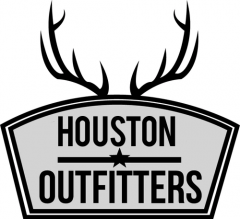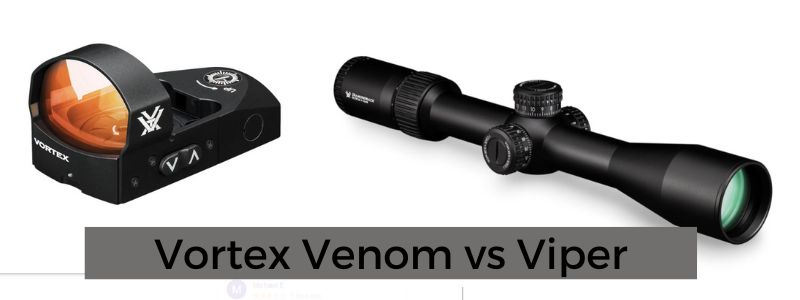In this article, we are putting face to face the vortex venom vs viper, so you can pick the best of them. Both the products are amazing each with their distinct features sharing similar functions yet has noticeable differences seen. So which one is best for you? We are here to help with a comparison of the two side-by-side to make your choice a bit easier.
Comparison between Vortex Venom and Viper
Both Vortex sights are similar in performance, quality, and waterproof & shockproof to sustain the impact of recoil. The later is slightly smaller than the Venom making it the best choice for you to use with a pistol. However, if you need a more versatile sight, the Venom works with both pistols and rifles.
Even changing the battery is less complicated in comparison with the Viper. Due to the restrictiveness of the battery compartment, it does have a more compact design than the Venom.
Upon purchase, both the mini dot optics have the same accessories included. You get a Picatinny mount, Torx wrench, lens cloth, protective cover, and battery.
The Vortex VIP Unlimited Lifetime Warranty covers both of the sights and protected against defects and failures.
Optic Description and Features
Both sights have a compact design, but the Viper profile is lower and works best with handguns, offering a 6 MOA dot. The Venom offers you 3 MOA red dot making it ideal to use with long guns and handguns.
Both of them have a durable aluminum construction with fully multi-layered coated lenses. The multi-coated lens helps increase light transmission while reducing glares providing extreme clarity. The Venom objective lens size measures 26.5mm compared to the other one, that is 24mm. Both offer a 1x magnification power.
What makes the Viper stand out from the latter is it allows you to co-witness it with suppressor pistol sights. Where the Venom excels is the user-friendly design as the battery compartments at the top compared to the Viper. With the structure, you can leave the optic mounted during a battery change.
Both sights have a matte finish with waterproof and shockproof construction to protect it from the elements. The brightness controls located on the side of both and easily accessible. The MOA settings are set into the body and guard it against unintentional changes.
What’s more, is that both provide you ten levels of brightness settings with the Viper controlled manually and the Venom offers you auto and manual modes. The Viper uses a CR 2032 battery but has the same battery life of 150-hours as the Venom using a CR1632 battery.
Furthermore, both offer you a 14-hour auto-shutoff with a battery use of 30,000 hours on the lowest setting. The only difference here is you need to remove the Viper to replace the battery.
Cost Comparison
You can purchase both the Venom and Viper for under $250, making them affordable options to buy. Many sights from other brands cost more.
Further, both the optics is equal in design and performance making them reliable to use.
Both have the same build quality, controls, and features with the same battery use—but they do use different batteries. The main dissimilarity between the two is the two different sizes of dots available in the Venom, and it has a larger size than the Viper.
What makes the Venom unique is you can use it with more than one application (handguns and rifles.) With the smaller dot, you get precision when shooting. You can also use it as a backup with a magnified scope using the larger dot.
Therefore, if you need a sight with multiple uses, the Venom remains the best option. Compared to the Venom the Viper’s primary purpose is on handguns as the small size works well on pistol slides. With the larger dot, you get accuracy and quick targeting.
Alternatively, you can use the Viper with a rifle but not intended for this purpose. However, if you need speed for a pistol, you will not be disappointed with the Viper. Better use other specialized rifle scopes.
Which is the Best Mini-Red Dot Optic
Both the Venom and Viper is compact and great options to use. While the battery use is short on the bright setting, the automatic shutoff and extended battery use on the lowest setting makes up for it. Both sights are similar in construction, features, and quality.
The image quality of the Viper is not as bright compared to the Venom offering you clear image quality. Nonetheless, both have the same maximum click for windage correction of 100-MOA and 130-MOA for elevation correction.
Therefore, the choice depends on the use of the optic. If you need a mini-red dot sight fulfilling multiple applications, the Venom remains superior. However, if you only need one to use with a handgun, the Viper is sure to become your companion in any situation.
Either way, you are getting a sight that will last a lifetime.
How to Mount Vortex Venom?
Venom comes with a low mount (18mm), which is compatible with a rail with slots (holes). Therefore, you can’t fit the sight on a grooved base or a rail with slide cutouts. If your firearm doesn’t have a slotted rail, you’d need to purchase it from dealers.
The low mount is suitable for handguns and shotguns but the package comes with a riser, which you can use to increase the height to the level of AR15 rifles and pistols.
Follow the following steps when clamping the sight onto a slotted rail:
- Use the available screws to clamp the low mount to the frame of the sight.
- On the slotted rail of your firearm, clamp the sight, placing the recoil lug firmly into the slots.
- Check whether you inserted the clamp fully into the slots and whether it’s attached to the exterior of the rail.
- Push down the sight and slide it forward along the rail toward the bore of your firearm.
- Fasten the clamp screw firmly on the rail using a flattop screwdriver or a coin.
How to Zero Vortex Venom
Zeroing enables you to determine you needs: cartridge and maximum range, before you embark on shooting or hunting.
When you know exactly what you want, you won’t waste money on a firearm, which gives you extra ranges. Zeroing also enables you to make the most out of your cartridge.
We recommend you choose a short-range distance at first. A zero distance of between 25- and 50-yards is suitable.
Bore Sight First
But before you embark on zeroing, you need to look through the bore of the barrel of your firearm. When bore sighting, follow the steps below:
- Extract the bolt from your rifle for a clear view.
- Look through the barrel.
- Center the bullseye inside the barrel.
Zero Your Sight at the Range
Once you finish bore sighting, it’s time to zero your sight at the range.
- Place a shot once or twice at the target.
- Examine the groupings to determine how far off the bullseye the bullets have landed.
- Fire three shots this time.
- Examine the groupings, and measure how far off the bullseye the center of the groupings is located. Make corrections for windage and elevation as necessary based on the center of the groupings (See below).
- Again, fire three shots and examine how far the center of the grouping is located from the bullseye. Repeat the procedure when unsatisfied.
How to Make Corrections for Windage and Elevation
One MOA is equivalent to 1.05-inches at 100-yards. If you chose 25-yards as a sight in distance, then you require to hear 1-click to move the point-of-impact of the bullet by ¼-inches. Or, ½-inches at 50-yards, 0.3-inches at 30-yards, etc.
And so, if the bullet landed at a 25-yard target 4-inches to the left of the bullseye, that’s a result of wind drifts.
On one side of the frame, there is a dial for windage adjustment. Rotate the dial down (clockwise) to until you hear 16 clicks to move the point-of-impact 4-inches to the right.
How to Aim Vortex Venom
If you mounted and zeroed your sight correctly, aiming or holding down your sight shouldn’t be a problem.
As long as you’re able to see the red dot reticle, you can acquire targets easily and fast.
Be careful, though.
Red dots offer you an unlimited eye relief, but this doesn’t mean you place your eye too close to the ocular lens lest recoil shocks and impacts hit your face, leading to injuries. Look for a comfortable distance of your eyes from the eyepieces.
We recommend you place your eye at least 4-inches away from the ocular lens when aiming.
Conclusion
After comparing the Vortex Venom vs Viper, we have to say that both are the lightest and most compact sights available on the market, with outstanding build quality. Built to withstand heavy recoil, Vortex anodized the aluminum chassis. More than that, anodizing on both sights has a matte black finish, which removes flares and reflections, which irritate and obstruct your vision. The anti-glare finish on the chassis construction also provides you with stealth abilities.
ArmorTek layer on the both chassis contributes to toughness and resistance against shocks and impacts of hitting, dropping or recoil. O-ring seals prevent water, oil and dirt from damaging the optics and internal components. Contributing to optical quality are multiple coatings, which cover the lenses completely to maximize on the available light. While Viper is slightly heavier than Venom when you add a mount, it’s more compact, as its length is shorter. Viper uses a most common battery – CR2032. Venom uses a rare form of battery – CR1632.
However, when it comes to changing batteries, it’s easier with Venom than Viper, as battery compartment is on top. No need to dismount the sight. Both sights have an auto shutoff feature after 14 hours. But Venom has both auto and manual modes for brightness settings. Viper has lock screws which you need to loosen before you start making corrections for wind drifts and bullet drops. Venom has none. And so, depending on your needs and preferences, choose either sight, as they cost more or less the same.

